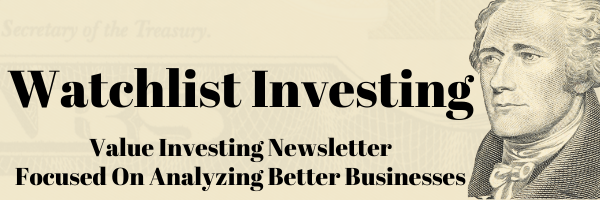Anyone who has studied Warren Buffett for more than five minutes knows that he takes a long-term view. Up until a few years ago I did not realize just how long “long” really was, and what that frame of mind meant in terms of clarity of thought. Most wouldn’t disagree that ten years—a decade—is long-term. However, even this span of time is barely enough room for one business cycle.
After reading a recently-released transcript of the 2010 Financial Crisis Inquiry Commission (FCIC) interview (link: here) of Warren Buffett, and attending the 2016 Berkshire Hathaway Annual Meeting, I realized that in order to think on the same plane as Buffett (and therefore reap the benefits of his thought process) my time horizon needed to expand. If infinite is in fact too abstract for practical use, then generations would be the next best frame of reference. First, I’ll present the comments that led me to my conclusion, and then I will discuss what I believe are the implications of such an approach.
Financial Crisis Inquiry Commission Interview
In May 2010 members of the newly-formed Financial Crisis Inquiry Commission (FCIC) interviewed Warren Buffett in the hopes that the Oracle of Omaha might add some clarity to what caused the Great Recession, and how to prevent something like it from happening again. Within the 103 pages of the transcript (others have since reduced it to 23 single-spaced pages) lay several nuggets of gold, there in plain sight:
- Home prices as a function of replacement value: Buffett noted that while it appeared that buying a home was a good investment because it went up in value over time, what was really happening was the dollar was going He explained that over time houses reflect replacement value. (Not content to take Buffett’s word on it I checked the math. Using St. Louis Federal Reserve data, I found that home prices increased by 5.4% per annum over the last 50 years (1966-2016). Inflation over that time was 3.6%. My best guess is that the remaining 1.8% per annum increase could be because houses have increased in size over the last few generations. At the very least that is a small amount of extra appreciation, and validation in my mind of Buffett’s assertion.)
- Farmland: Another real estate-related example. Buffett gave the example of when he purchased a farm from the FDIC because a bank had over-lent to the borrower who purchased it and subsequently failed because of its poor underwriting standards. Buffett’s analysis was as piercingly insightful as it was simple. The bank lent a farmer $2,000 per acre to buy a farm producing a normalized $60 per acre when interest rates were 10%. How could disaster not occur when the asset produced a loan yield of 3% ($60/$2,000)? Buffett purchased the farm from the Bank for $600 an acre—a 10% yield on cost. Buffett still owns it today, some 30 years later.
- Hedging at Burlington Northern Santa Fe: This struck me perfectly obvious yet overlooked. Buffett told the Commission that if he were running BNSF he would not hedge fuel costs, a major input cost at the railroad. Why? Because over time the plusses and minuses cancel out. And what’s left? The frictional cost of the hedging program, of course.
- No substitute for U.S. Treasuries: At Berkshire, Buffett explained, there are no substitutes for Treasuries. Even if a little more yield could be had investing surplus cash in commercial paper, Berkshire will not do it. Why? Buffett: “Because I don’t know what can happen tomorrow”.
2016 Berkshire Hathaway Meeting
Question 34, asked by Andrew Ross Sorkin of the New York Times, was about the due diligence process Berkshire employs when making acquisitions. Namely, no armies of lawyers, bankers, consultants, etc., just Buffett taking a few minutes (sometimes literally) to size up a deal. Buffett explained that while the checklists put together by lawyers for due diligence were generally useful for making sure simple mistakes weren’t committed, the real errors never show up on a checklist. Rather than try to paraphrase, I’ll let Buffett speak for himself. Never to let an opportunity for a wisdom-packed quip go by, Charlie Munger succinctly summed up the argument with something most could relate to.
Warren Buffett: It’s interesting. We’ve made plenty of mistakes in acquisitions…the mistakes are always about making an improper assessment of the economic conditions in the future of the industry or the company. They’re not a bad lease, they’re not a specific labor contract, they’re not a questionable patent. They’re not the things that are on the checklist, you know, for every acquisition by every major corporation in America. Those are not the things that count. What counts is whether you’re wrong about — whether you really got a fix on the basic economics, and how the industry is likely to develop or whether Amazon is likely to kill ‘em, you know, in a few years, or that sort of thing. And we have not found a due diligence list that gets at what we think are the real risks when we buy a business.
[Emphasis mine]
[…]
…When we bought See’s they probably had 150 leases. When we [bought] Precision Castparts they have 170 plants, you know. There’s going to be pollution problems at someplace. That is not what determines whether a $32 billion acquisition is going to look good 5 years from now or 10 years from now.
[…]
Charlie Munger: How many people in this room who are happily married carefully checked their spouses birth certificate and so on? My guess is that our methods are not so uncommon as they appear.
The Aha Moment
After reading the FCIC Interview I had a sense that there was a big lesson to learn from emulating Buffett’s very long-term thinking habits. It was only after sitting in Omaha at the Century Link Center listening to Buffett answer the question about due diligence that I realized this is not just the way Buffett thinks. This is the way he actually invests money.
The natural question is, ‘how does this work?’ How can you go about buying actual businesses with actual money (lots and lots of money in Berkshire’s case) without doing enormous amounts of due diligence? Why wouldn’t you have an army of highly-trained lawyers scrub every contract, every lease, and every patent, before laying out $32 billion? Because if you take a very long-term view those things don’t really matter. Further, all that extra work could, in fact, become a distraction. When you use as a timeframe decades (plural) or generations, most of what others think important fades to the background and you can see clearly before you the things that really matter.
In the long run the small details don’t matter. In some year’s fuel costs at BNSF are higher as a percentage of revenues, some year’s windfalls are generated when costs unexpectedly go down. Over time neither the railroad nor its customers/suppliers “wins” or “loses”. Each gets the average result according to their long-term position in the economic sphere. If you are going to end up with an average result over time why would you rationally entertain the idea of laying out money to smooth things out? (Of course, we know why. Wall Street hates volatility, and managers of companies are implicitly or explicitly incentivized to “smooth” earnings.)
The fact that Buffett will not invest surplus cash in anything but Treasuries contains a lesson in itself. If you take the very long-term view everything that can happen will happen – eventually. If you were told you would live for 1,000 years would you settle near a fault line or close to the shore? Probably not. You would know that you could expect several large earthquakes and 100-year floods during your lifetime. You’d consider as common the probabilities that investors often dismiss as too remote to worry about, and you’d act accordingly. When you step back from the noise you see that it’s foolish not to be prepared for rare but potentially highly-damaging risks, regardless of how small the probabilities are.
Putting it to Work
Translated into the investment process what this means is that most investors, myself included, would be wise to tune out short-term noise to a much greater degree. If you really were going to live for 1,000 years would you check stock prices every day? Would you pay even the slightest attention to pundits and other short-term prognosticators? Would you stress about the hundreds or thousands of unimportant details?
No, of course you wouldn’t.
That is not to say you would have an excuse to be lazy or put off thinking deeply about your investments. You would, however, operate with the calm and the confidence that comes from having a very long time horizon. Blessed with such a life-span, what would you do? Buffett already gave us the answer: Focus on “the basic economics of the business and how the industry is likely to develop”.
The good news is we don’t need a 1,000-year life span to benefit from long-term thinking practices. We can get started right now.

